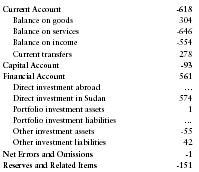Sudan - Balance of payments
There is a habitual payments deficit and Sudan continues to suffer from a severe shortage of foreign exchange. Remittances from Sudanese working abroad are discouraged by inequitable exchange rate policies. The 1997 trade embargo with the United States added to stresses on the balance of payments. However, Sudan began implementing IMF macroeconomic reforms in 1997. Sudan began exporting crude oil in 1999, and in the fourth quarter of that year, the country realized its first trade surplus. Approximately 70% of Sudan's crude oil production is exported. The country's external debt stood at $24.9 billion in 2000, most of which was in arrears, and international credit is generally not available to Sudan.
The US Central Intelligence Agency (CIA) reports that in 2001 the purchasing power parity of Sudan's exports was $2.1 billion while imports totaled $1.6 billion resulting in a trade surplus of $500 million.
The International Monetary Fund (IMF) reports that in 2001 Sudan had exports of goods totaling $1.7 billion and imports totaling $1.4 billion. The services credit totaled $15 million and debit $660 million. The following table summarizes Sudan's balance of payments as reported by the IMF for 2001 in millions of US dollars.

| Current Account | -618 |
| Balance on goods | 304 |
| Balance on services | -646 |
| Balance on income | -554 |
| Current transfers | 278 |
| Capital Account | -93 |
| Financial Account | 561 |
| Direct investment abroad | … |
| Direct investment in Sudan | 574 |
| Portfolio investment assets | 1 |
| Portfolio investment liabilities | … |
| Other investment assets | -55 |
| Other investment liabilities | 42 |
| Net Errors and Omissions | -1 |
| Reserves and Related Items | -151 |